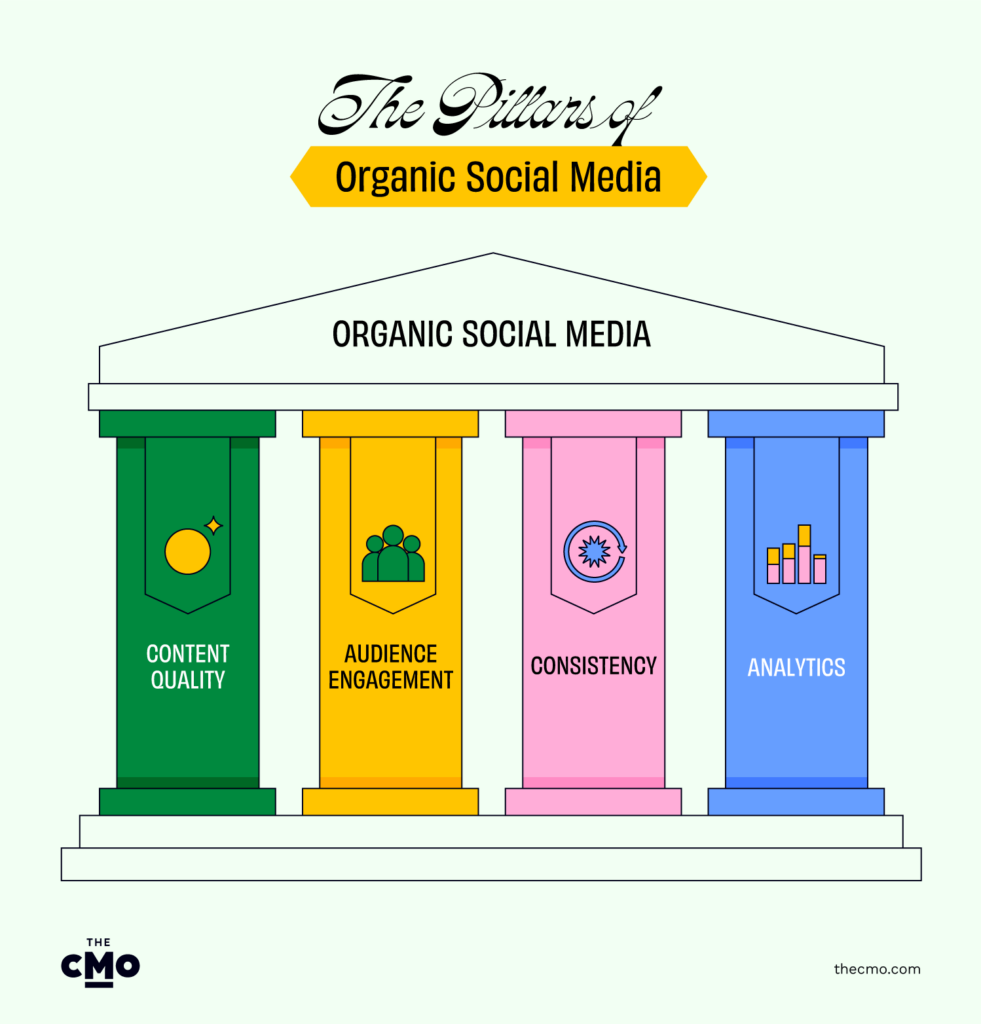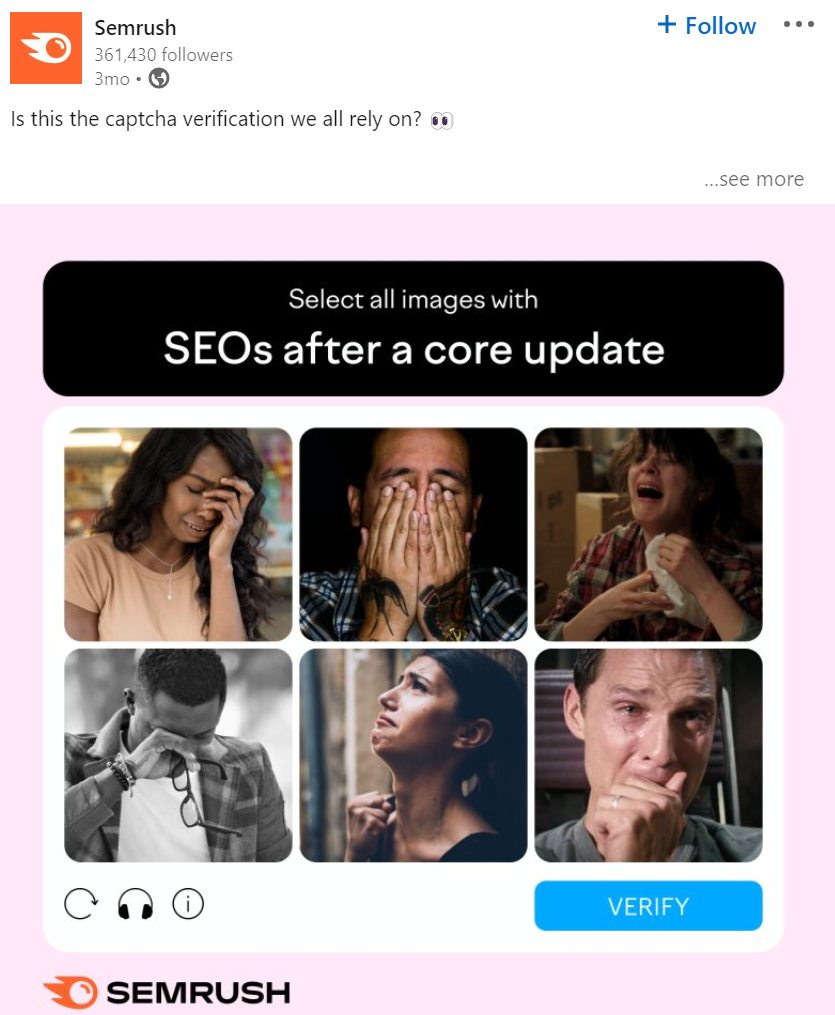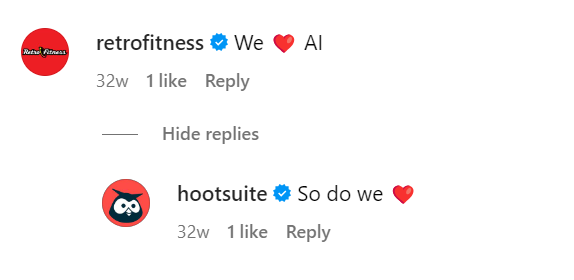The umbrella of digital marketing stands above several effective marketing practices, but only one is the true master of fostering authentic connections.
Organic social media marketing refers to attracting, engaging with, and retaining an audience without relying on ad spend. That means it relies solely on content that resonates with the audience to inspire genuine interactions.
Some of the leading reasons for businesses using social media marketing include increased exposure and traffic, and with more eyes on your business, it’s only natural for you to want that to lead to long-term brand loyalty.
But before you dive into posting all types of content or start looking at which social media marketing course to throw your money at, there are several things to keep in mind. I'll start with the essentials.
Organic Vs Paid Social Media
The difference between an organic vs paid social media strategy is that no budget or ad spend is required for content promotion in an organic strategy. While paid social media includes a budget for advertising dollars, the costs for organic social media come only from the planning and creation of content.
Particularly popular with small businesses and startups, organic social media will use free tools provided by each social network to build and engage with a community of followers.
The Pillars Of Organic Social Media

Content Quality
At the heart of any successful organic social media strategy lies compelling content. Contrary to what many people think, great content isn’t just made up of beautiful photos and eye-catching video. If you want organic reach, you’ll need a combination of quality visuals and strategic, keyword-focused messaging that helps tell a bigger story.
One SaaS brand nailing their content marketing across LinkedIn, Twitter, and Instagram is Semrush. Their relatable use of meme marketing mixes trendy visuals with relevant messaging that speaks directly to their target audience.

Audience Engagement
Social media is a two-way street—if you want something you have to give it. Actively engaging with your audience through comments or direct messages can help build a sense of community around your brand.
Not having an engagement strategy is a common pitfall in organic social media marketing, which I’ll cover in detail along with how to build a strategy later on.

Consistency
Regular updates on social media accounts keep your brand at the forefront of your audience's minds and shows off your commitment to staying engaged.
But how often is too often to post organic content?
There is of course no simple answer to this. First, there will always be algorithm changes, so the first rule will always be to run your own tests, find out what works for you individually, and stay on top of the latest updates.
With that said, a 2023 study by Hootsuite discovered that the ideal number of posts per week on Instagram was between 3-5 combined with 2 Stories daily. Twitter was 2-3x/day, while Facebook and LinkedIn were 1-2x/day.
| Social Media Platform | How Often to Post |
| 3-5 posts and two stories daily | |
| 1-2 posts per day | |
| 1-2 posts per day | |
| Twitter (X) | 2-3 posts per day |
Analytics
Analytics is the only way to track KPIs (key performance indicators) and measure success in organic social media, and if you’re a business investing time and resources into social media marketing, those are two things that need to be on your radar.
Read till the end (the 'Measuring Success' section) to find out which metrics you should be most focused on when measuring success for organic posts.
Platform-Specific Strategies
By the time you add organic social media into your marketing mix, you probably already have a platform in mind you want to work on.
Unlike paid social media marketing, where you can target specific audiences based on demographics and behaviors, organic relies on the right audience already being there.
That’s why the platform you choose should be the place your target audience spends the most time online, and you need to have a good understanding of the platform’s algorithm to build out a proper strategy.
Let’s take a closer look at a few platforms, so you can be fully prepared.
Facebook (META)
To this day, META remains the most popular social media platform with around 3 billion monthly users. So how can you utilize it to your business’s advantage?
Since I started my own business in 2019, I’ve personally noticed a huge drop in organic Facebook engagement, meaning it definitely comes across as more of a pay-to-play platform in 2023.
So, want to build an organic audience on Facebook with zero ad spend?
Here are a few things you'll need:
- A solid understanding of your target audience.
- Specific, attainable goals. You’ll need these defined before posting anything to your business page if you want to track KPIs and measure success.
- A content strategy, or more simply, what you’re going to post and when.
Start by figuring out the primary differentiators about your business, and the key messages you want to get across to your audience, then build out your content pillars with that messaging in mind.
If available, use past data to point you in the right direction in terms of what has worked well in the past, and when your audience is most active on the platform — i.e. The best time for you to post.
Need help with content ideas? META mentions the rule of thirds in their recommendations, where:
- One third of your content is aimed at providing value to work toward increasing your brand awareness
- One third is shared content that encourages interaction with your audience
- One third is promotional content, highlighting what you do best with the purpose to sell.

While Instagram is owned by META and has a similar algorithm that prioritizes content you’re most likely to engage with in your feed, there are some key differences you should consider when posting on this platform.
According to Later Media, a content scheduling software primarily focused on Instagram, there are three steps to finding Instagram success:
- Reach New Audiences
- Posting both Reels and Carousel Post formats
- Collaborating via influencer marketing or partnering with other brands who have overlapping target audiences to yours.
- Optimizing your Instagram name with a relevant, highly searched keyword. SEO is a thing on Instagram, and you should be using strategic wording wherever possible.
PRO TIP: Instagram and its partners have recommended you avoid adding your brand logo on the majority of your social media posts, and posting content with watermarks from other platforms. These faux pas can decrease your reach and limit your chances of ending up on their Discover page.
- Convert Visitors Into New Followers
- Writing an Instagram bio that tells visitors who you are, what you offer your followers, the area you service, and a CTA that inspires a desired action.
- Organizing your Story Highlights into binge-worthy categories
- Having a cohesive, well-branded grid aesthetic. Make your marketing efforts work for you and stick to a brand guide for all designs.
- Pin up to three strategic posts to the top of your grid to highlight what you want new visitors to know most about you. This can be anything from cool partnerships to service offerings — don’t make it all promotional.
- Build Community
- Use a mixture of strategic content to appeal to the community you want as customers. This can include content that resonates with your target audience, shows off your industry authority, and social proof, AKA testimonials and user-generated content (UGC.)
- Use features like Instagram Stories and Lives to show off a more human side of your business. These platform features allow you to interact with your audience, address questions, and offer sneak previews of what’s coming up all in real time.
- Use CTAs in posts to encourage direct messages and comments whenever possible. These forms of engagement are invaluable for fostering community, and with AI and automations, you can now provide timely responses to FAQs to benefit customers needing answers…yesterday.
Twitter (X)
Are we all calling it X yet? This one is the wallflower platform that’s different from everybody else. It boasts in-the-moment thoughts, immediacy, and quick, effective ways to share fresh content. With its unique features comes alternative rules and strategies for success.
Internally, X has researched content over the years to identify top-performing strategies that work well across the board. This includes the following:
- First, their data shows over 2 billion video views per day on the platform, so they recommend prioritizing short video in your content strategy. Rememer to add your company logo and subtitles.
- Ensure your messaging is concise, contains clear purpose and a strong CTA. The point of any piece of content is to get engagement, and what better way to start an engaging thread than with an intriguing conversation starter?!
- Include timely, relevant hashtags — but only 1 or 2. These can help you expand your reach and tap into relevant conversations.
- Launch new business things! X claims they’re the best platform to host successful launches, whether it’s a new promo, product, or rebrand, it might be worth a shot for your 2024 promos.
LinkedIn offers a unique space for B2B marketing and professional networking. Here are a few best practices LinkedIn has outlined for anyone marketing on the platform in 2023:
- Post 1-2x per day
- Use rich, eye-catching visuals — especially quality video.
- Ask questions that encourage comments
- Take advantage of all available features. Pages with complete information get 30% more weekly views
When outlining a strategy for this platform, engagement should always be top of mind, whether you’re aiming to improve Click Through Rates (CTR), gain comments, or increase shares.
With that in mind, here are a few ways to increase engagement on LinkedIn:
- Use the 4-1-1 Rule: For every piece of original content you post, you should complement it with four pieces of curated content sourced externally, and one promotional post designed to drive sales as the final touch.
- Keep it Short and Sweet: LinkedIn recommends 150 characters or less when it comes to text accompanying a post, and that’s likely because they’re transitioning into a more visual-forward platform.
- Respond to Comments: Much like any other platform, if you want to gain trust and continue to get engagement, you can't stop at posting. When people take the time to engage with your content, respond!
- Use Hashtags to Filter Your Content Properly: Hashtags are used to help categorize content so the right people see it. If you want to get in front of a certain audience, using tags that audience commonly uses.
Content Planning And Calendars
In social media, the best way to capitalize on the most opportunities through your campaigns is to plan content in advance so you never miss a beat.
The Importance of a content calendar
A content marketing calendar is a valuable tool in organic social media management, as it provides structure, efficiency, and the ability to align your content with specific business goals. It helps brands establish a consistent, engaging, and strategic presence on their designated social media platforms.
As for what to include in a content calendar, you'll want to feature topics, keywords, categories, publication dates, headlines, and content formats.
Tools for content planning
Alongside your content calendar, you’re probably also going to want a content scheduling platform. There are a ton of social media marketing software and platforms to choose from, and they’re great for keeping you accountable to your calendar by allowing you to schedule all your posts in advance.
Best Practices
Contrary to what I see a lot of, planning ahead doesn’t mean you need to schedule posts months in advance. In fact, I never schedule social media longer than 2.5 weeks in advance for my clients, and here’s why.
Social media is always changing, so you need wiggle room to move content around to hop on new trends before it goes out of style, insert a sweet moment from the office day, or update your audience on something unexpected, without disrupting your content plan or grid aesthetic too much.
Keep in mind, these on-the-fly content insertions are minor blips that shouldn’t happen often, because if you were to consistently post without strategy, some consequences could include:
- Coming off as random or inconsistent to your audience and peers, resulting in lower reach, engagement, and slower growth
- Lacking full thought or posting a mistake — as little as a typo, or as big as something that could get you canceled.
- Losing out on opportunities to connect with the right people and potential customers due to change in tone of voice, targeting etc.
Oh, and let's not forget how important it is to optimize for social search.
Measuring Success
Key Performance Indicators (KPIs)
For organic social media strategies, key performance indicators (KPIs) act as a baseline for assessing return on investment (ROI).
Good metrics to track for this include:
- Engagement Rates: Measuring likes, comments, and shares to gauge the level of interaction with your content. Higher engagement rates indicate a more involved and interested audience.
- Follower Growth: Though I don’t recommend this as a primary goal, seeing steady growth in your follower count over time signals that your content is resonating with new audiences.
- Click-Through Rates (CTR): If you share links in your posts, monitor the CTR. This metric reflects how successful your content is in driving traffic to your website or landing pages.
- Conversion Rates: If your goal is to drive specific actions like sign-ups or purchases, you need to track those conversion rates with external tracking software. This helps you understand how well your social media efforts are translating into tangible results.
Google Analytics, Facebook Pixel, Twitter Conversion Tracking, and LinkedIn Conversion Tracking are great tools to help track ROI. - Sentiment Analysis: Pay attention to how people speak about your brand online. Social listening tools can help you gauge whether conversations are positive, negative, or neutral, and from there, you can take necessary action.
Tools for analytics
Lucky for all of us, social media platforms offer free insights on all our content, if you’re registered as a business account!
Use these to your advantage, or if you use social media analytics software like Hootsuite, Loomly, or Later Media, you’ll also be able to find relevant analytics from any content posted through their schedulers!
Common Pitfalls And How To Avoid Them
Inconsistent Posting
Posting sporadically or inconsistently can lead to a drop in engagement and make it challenging to build a loyal following.
When I land on a larger business’s page that hasn’t posted in the past 7+ days, my first thought is that they don’t have a strategy in place. If that’s true, it’s likely they have a smaller team than they might want people to believe.
To combat this, simply create a content calendar and invest in a content scheduler to post your strategically planned content on demand.
Poor Quality Content
While content trends come and go, one rule remains the same in social media marketing—never post poor-quality content.
Apps like Instagram and Pinterest in particular have made a name for themselves around scroll-worthy, high-quality content like beautiful images and infographics, and with billions of users vying for attention online, it’s just too easy to scroll past content that isn’t up to snuff.
Investing in professional content creators, influencers, photographers, or videographers are great ways help you look your best every time you post, but if budget doesn’t always allow for professional content, I’ve got some pro tips for shooting with your iPhone:
- Before you shoot anything, clean your camera lens. Just look at the difference it makes in this Reel.
- Turn on your camera’s grid in your iPhone settings for ideal composition
- Optimize your phone’s camera settings, starting by turning your video record settings to 4K at 24 or 30 fps.
PRO TIP: If you’re designing your own graphic without photos, make sure to use an information hierarchy, without overdoing it on text. After all, attention spans are lower than ever and reading is a tall order for most social media scrollers.
When posting graphics, you also want to avoid random colors and fonts. Stick to your brand’s guidelines to ensure every post is recognizable. Canva’s free account option is a great resource to help create branded designs from desktop or mobile.
No Engagement Strategy
If you’re looking to build a larger, loyal community around your brand, posting and ghosting is not the answer.
You need an engagement strategy to give your content its best shot at reaching new audiences. So what goes into an engagement strategy?
- Step1: Define your target audience or ideal customer. Figure out where they spend their time online, who they interact with the most, and the types of people who influence their purchases.
- Step 2: Make a list of real people online within that target audience, who you’d like to become a customer.
- Step 3: Start engaging with them on a regular basis, using my 3-2-1 rule as an engagement guide — Like three of their recent posts, genuinely comment on two things — a story and a post— and give them a follow for one month.
I don’t know about you, but I always feel seen when a big brand engages with me on social media channels!
As you might have noticed, I’m a big fan of all things Later Media, and I can tell you, when I interact with their content on social media, they always respond, even if it isn’t always immediate (they do have 519K followers to tend to after all.) That’s a true sign of a brand who values connection with their audience.
So, Ready To Go Organic?
As you now know, organic social media is not just about posting content, but creating a vibrant, engaged community that resonates with your brand's story.
By understanding the primary pillars, adopting platform-specific strategies, measuring success through relevant metrics, and avoiding common pitfalls, businesses can start profiting off of social media marketing.
Ready to grow? Subscribe to The CMO newsletter to stay on top of trends and get the latest tips, resources, and guides from our community of seasoned marketing leaders straight to your inbox.


